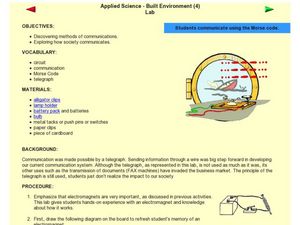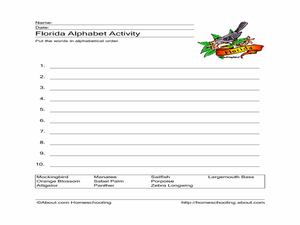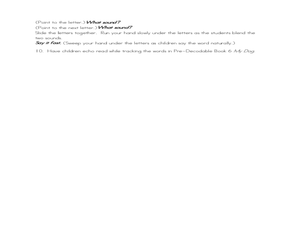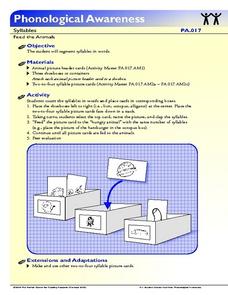Curated OER
Alligator
Young scholars investigate the musical concept of rhythm through the use of creating a beat. The beat must have a specific and purposeful rhythm. Student can then define the term of rhythm easier after performing the activity.
Curated OER
Nocturnal Animals Cloze Activity
In this science cloze activity, 3rd graders fill in the 9 blanks in a selection about nocturnal animals. They use the words from a word bank at the bottom of the page to complete the paragraph. They cut out pictures of nocturnal animals...
Curated OER
Picture Scramble: Manatee, American Alligator, Brown Pelican
In this science and visual discrimination worksheet, students examine images of a manatee, American alligator and brown pelican. Next to each picture is the same image which has been divided into 9 pieces and scrambled. Students place...
Curated OER
Dr. Suess's ABC
Students complete a variety of activities related to the book "Dr. Seuss's ABC." They discuss the imaginary animals from the book and create a drawing of their own animal for the letter Z, and locate each letter on an alphabet chart...
Curated OER
Communication Methods
Students explore communications by participating in a science class activity. In this communication technology lesson plan, students discuss the process of morse code, its history, and the electromagnets used to create the device....
Curated OER
Electrical Circuits
Students compare series and parallel circuits. In this electricity and circuits lesson, students roleplay as a "wire" passing an energy ball to demonstrate how a series circuit works and how the circuit can be broken. Students construct...
Curated OER
Florida Alphabet Activity
In this Florida worksheet, learners put words in alphabetical order having to do with Florida's famous people, places, and history. Students put 10 words in alphabetical order.
Curated OER
See You Later, Alligator
Students explore the historical and social significance of animals as cultural symbols in various countries around the world, as well as the impact that humans have made on the population and natural habitats of these animals.
Curated OER
ABC...Have Fun With Me!
Throw out those old ABC worksheets and try some new and engaging hands-on activities to teaching the alphabet!
Cornell University
Build a Fuel Cell
Discover the connection between redox reactions and fuel cells. Collaborative groups build a Hoffmann Apparatus that demonstrates the electrolysis of water and then convert their models into a fuel cell. They use their fuel cells to...
Curated OER
Crawdad Grab
Students explore biology by conducting a freshwater fishing activity. In this crawdad activity, students discuss what a crawdad is, where they are found and how they can be prepared as a meal. Students utilize string, alligator clips,...
Curated OER
Introduction to Photovoltaic Systems
The Green Education Foundation found that this lesson plan, written by the Texas State Energy Conservation Office, is right up their alley when it comes to teaching sustainability. It is ideal as a first lesson plan on photovoltaic...
Curated OER
Malapropisms
What's the difference between an allegory and an alligator? Fifth graders work with malapropisms to determine the meanings of words that sound alike. Five sentences challenge them to find the malapropism and change it to the correct...
Curated OER
The Shocking Truth About Fruit
Looking for a great lesson plan on circuits and conductors of electricity? Take a look at this one! In it, 6th graders create circuits out of pennies, washers, alligator clips, fruit, and LED’s. Learners use voltmeters to analyze the...
Curated OER
Small Group: BL
Practice target sounds, especially the /a/ sound. The teacher first speaks and learners repeat words, discriminating between words with varying sounds after focusing on /a/. Letter cards are held up to show the symbolic representation of...
Curated OER
A Weigh we Go!
Here are some cross-curricular activities whil should help your kids understnad weight measurements and grammar. In this grammar and math lesson, students read the book Skittles Riddles and practice counting and balancing skittles. They...
Exploratorium
Sound Bite
Learners use their teeth for more than just eating. The activity shows class members how to send sound through their teeth by using an electric motor connected to a radio to generate vibrations. Biting on the motor transfers the...
Florida Center for Reading Research
Phonological Awareness: Syllables, Feed the Animals
An activity challenges scholars to sort picture cards based on the number of syllables they count as they say the item's name on each card. Depending on how many syllables they count, they place the card in the corresponding box...
Curated OER
On The Light Side
Kindergartners identify different sources of light in a science activity. They view pictures of a flashlight, a match, and a lamp, among others, and color the part of the picture that creates light. A science activity prompts them to...
Curated OER
Verbally Speaking
Verbs are the center of attention in this resource. Students discover that a verb shows action, then they consider twenty sentences that each have an action verb. Students must click on one of three words at the bottom of each slide in...
Curated OER
Cartoons for the Classroom: Great Expectations
Learners can use this worksheet to discuss the expectations placed on the Obama presidency. Included are two cartoons to analyze, a web site to visit, several great discussion questions, and a short activity. This is one worksheet that...
Curated OER
Fragments, Comma Splices, and Fused Sentences
Identifying when to use commas, semicolons and other forms of punctuation can be difficult for students. This 10 question activity which relates to sentence fragments, could be used to help students identify correct use of punctuation.
Curated OER
Spot the Differences
In this spot the difference worksheet, learners analyze pictures of two
different alligators to see if they can find six differences between the
two.
Curated OER
Animals 1 - What Animal is It?
In this ESL activity worksheet, students respond to the question "What animal is it?" by using the 9 picture clues and word bank to assist them.

























